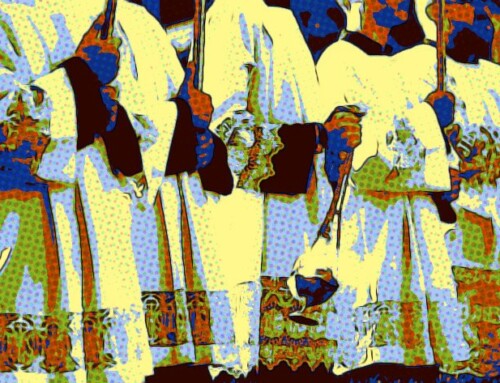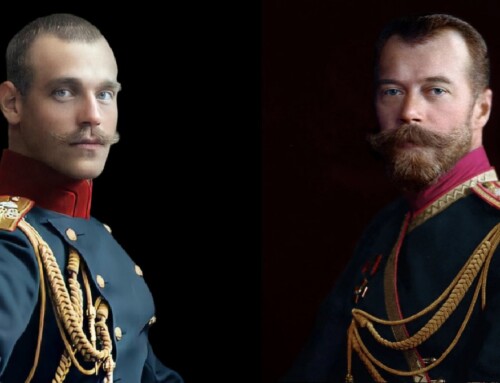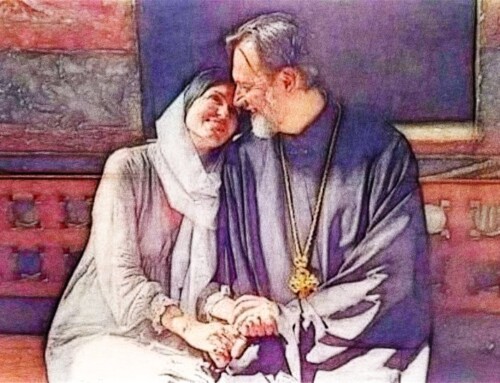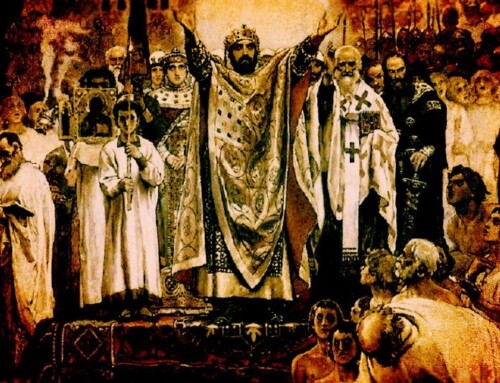“It is better to be unhappy and know the worst, than to be happy in a fool’s paradise.” ― Fyodor Dostoyevsky
In the year 2000, I went on a pilgrimage to France. One of my first stops was the former 12th century Benedictine Abbey of Sainte Marie Madeleine in the Burgundian village of Vézelay. Since I was an Art History student at UC Berkeley, I had been near obsessed with the Romanesque basilica which purportedly housed the relics of St. Mary Magdalene. Although I was not a Christian when I first studied the architecture and massive sculptural friezes of the Abbey, I became singularly focused on the impressively carved capitals which adorned the columns in the nave. In particular, there was a disturbingly surrealistic depiction of the rape of Ganymede. The capital referenced a tale from Greek and Roman mythology about Jupiter, disguised as an eagle, who kidnaps and ravages the handsome shepherd boy Ganymede. Zeus carries Ganymede back to Mount Olympus to serve as his cup-bearer. In a Christian church, a master artisan envisioned Ganymede suspended upside down from the beak of a large bird; the boy’s scream is frozen in stone. A thousand years later, despite the incredible beauty of the surrounding structure, it is still horrific.
Contemporaneous to the development and construction of Vézelay were the writings of Benedictine monk St. Peter Damian who railed against homosexual practices amongst the clergy. He wrote:
It would have been better to perish alone in secular dress than, having changed one’s clothes but not one’s heart, to also drag others to destruction, as the Truth testifies, saying, “He that shall scandalize one of these little ones that believe in me, it is expedient for him that a millstone be hanged about his neck, and that he be drowned in the depth of the sea.” And unless the force of the Apostolic See opposes it as quickly as possible, there is no doubt that when it finally wishes for the unbridled evil to be restrained, it may not be able to halt the fury of its advance.
For almost 20 years, I couldn’t understand why I was drawn to Vézelay and simultaneously disturbed by it. As a teenager, I had been victimized, but I couldn’t face the trauma; so, I buried the memory. I denied it, but it never went away. Instead, it haunted me. Unwittingly I was inclined towards a repetition of the abusive scenario: classifying myself by my desires and finding solace in an ever-narrowing definition of identity; accepting attention and affirmation from primarily older men; and I gravitated towards discrepant relationships in which I constantly sought out approval from my partner. But since childhood, I had been conditioned, from taunting boys at school and pop-culture, to believe that I was gay. I dreamed of hanging-out with the Village People at the YMCA. I knew I was different from the other kids; although I couldn’t articulate what was going through my mind, in my estimation – I guess I was born this way. It made sense. Yet, in my adolescence, especially during the advent of the AIDS crisis, I became increasingly apprehensive and confused; I was also subconsciously searching for guidance, when a seemingly benevolent priest simply confirmed what I was somewhat reluctant to accept. Only he added another component – God made me this way. I thought to myself, I couldn’t go against God.
“In keeping silent about evil, in burying it so deep within us that no sign of it appears on the surface, we are implanting it, and it will rise up a thousand-fold in the future.” ― Aleksandr Solzhenitsyn
Years later, I was still looking for direction. At the time, I was tired and frustrated; the ever-lasting camaraderie and approbation that I longed for since I was a boy seemed more elusive than ever. I felt as if I were going nowhere. Sadly, when we are weakened and vulnerable, we often attract predators. I met a Catholic priest – a mature and outwardly compassionate man. He knew my background; and, in hindsight, he used it against me. As a gay man, it wasn’t the first time I felt betrayed; and it wasn’t the last. But I walked away with an odd sense of defeat; as if I had just participated in my own degradation. I think from that moment on, I somehow lost all dignity. I became increasingly self-destructive and even suicidal.
And, despite everything – I still believed. That my destiny was indelibly linked to the way God had created me. I had brainwashed myself. But I wondered if my fate wasn’t similar to the men, I knew who perished from AIDS while still in their 20s and 30s. God had abandoned us. He gave us life, only to allow our needless suffering and death. A strange prophecy from the gay Jesuit John J. McNeill apparently came true:
“Since most gay people experience their homosexual orientation as a part of creation, if they accept this Church teaching, they must see God as sadistically creating them with an intrinsic orientation to evil. Most gays would prefer to see the Church teaching as wrong, rather than believe God is sadistic.”
I didn’t know, let alone understand “the Church teaching” on this matter, so I thought of God as the ultimate sadist. I got involved with BDSM; that was my way of getting close to a punishing god. But some amongst us did know. A few years before, a friend took McNeill’s advice: he reimagined Catholic doctrine on sex and marriage, got coupled with a potential long-term partner, and then, with the help of a renegade Catholic priest, married the guy. When his “husband” proved to be unfaithful, my friend eventually died of AIDS. I loathed a deity that would allow this to happen. Except, when He saved me.
Almost right away, I returned to the Catholic Church. I asked myself: Why? I didn’t really have an answer. Perhaps, once again, I was revisiting the location of previous abuse. I don’t know. But I was desperate and I was scared. I needed help. The God I imagined was merciful and just. I talked with a priest. But, that day, I felt as if I were seated across from my abuser. He said the same things.
With almost half of gay men experiencing same-sex molestation when they were boys, only those who have proven their stalwart and irreproachable character should be entrusted with ministering to such a uniquely vulnerable population. In reality, the opposite is the case. A relative handful of people who identify as LGBT ever turn towards the Catholic Church, but they oftentimes inevitably find themselves in a parish that is highly affirmative. Typically, these parishes are overseen by priests and religious orders that are predominantly gay. Here, in such an environment, those who are already confirmed in their sexual identity, either through previous abuse, trauma, and grooming, are further indoctrinated; those who are perhaps younger or unsure, become immediately surrounded by activists and same-sex couples. Oftentimes by Jesuits, pseudo-theologians, and various homosexual priests, the Bible is reinterpreted to reveal: the homoeroticism between David and Jonathan, Christ’s healing of the centurion’s gay lover as proof that He approved of homosexuality, and the special nature of Jesus and the Apostle John’s relationship.
The Catechism is denounced as a homophobic screed; except when strategically quoted on parish or ministry websites and in brochures that only mention how homosexuals “must be accepted with respect, compassion, and sensitivity.” The term “intrinsically disordered” has been changed to “differently ordered;” or even “intrinsically fabulous.” They are repeatedly told that “God made you gay.” For some, accepting the supposed divine origins of their sexual identity marks a final resolution to a lifelong struggle.
For me, it was the penultimate phase in the grooming process that ended with my acceptance of something that had nothing to do with God. Maybe what happened before: the constant teasing from other boys, feeling neglected by my father, becoming obsessed with pornography, caused my later homosexuality to become inevitable; but the Catholic Church permitted priests to prey upon those who were vulnerable – like me.
The problem is pervasive; particularly during the last several decades: predatory priests have risen through the ranks, been promoted into positions of authority, controlled the chanceries and the seminaries, and even become bishops and cardinals – as a result they have advanced the careers of those with similar proclivities; they have groomed and abused each other since before their ordination. They have instituted a culture of grooming in large segments of Catholicism. There is no corner of the Church that has not been touched.
They encourage young people to “come out and be honest and transparent and open about the way God created them;” while they themselves frequently refuse to do so.
Sometimes a Catholic LGBT ministry will hold their meeting at gay bars – with names such as “Bottoms Up.”
At the largest gathering of Catholic educators in the United States, the utilization of the “genderbread person” is unreservedly recommended.
The priests in charge compel members to remain Catholic, because it’s the only way the Church will ever change. Gay priests, who are oftentimes conspicuously close to their doting mothers, have manifested their inner battle; either because they are trying to get back at their unaccepting fathers, reconcile their awkward childhood, or reenact their own abuse at the hands of a priest, they have dragged men and women into their “gay civil war” with the Church. And as is often the case – the greatest casualties are among those on the front lines.
What that priest did to me, he did in the shadows; his grooming of me was nefarious and surreptitious; from the unknowing outside observer, he was just being kind. In a way, I can understand why no one was concerned. I can forgive. But something has changed. Now, it takes place in front of the bishops, in front of other priests, and in front of the laity. I have warned many of them; those in authority, who can stop this madness, do nothing. For that, it is difficult for me to find a place of forgiveness.
Because, when I returned to the Church – I knew instantly that something was wrong; the same priests who encouraged a long-dead friend to settle-down with one man, were still using the rainbow flag as an altar cloth.
I tried to find a refuge within the narrow confines of the burgeoning traditional Latin-Mass movement. But even there, I couldn’t completely escape. The seemingly ever-present bishop hung over the place like a specter; the priests feared him.
And when the Madianite merchants passed by, they drew him out of the pit, and sold him to the Ismaelites, for twenty pieces of silver: and they led him into Egypt. (Gen. 37:28)
After years of searching, I found a few priests and a couple of religious communities that I could trust. For a while, I lived a very quiet life; but then, I knew I had to go back.
At the various “pride” parades, gay festivals, and fetish street fairs, I started reaching out to those left behind – with a simple message: Jesus Loves You. I wasn’t going to proselytize, shout, or condemn. In San Francisco, in the city of St. Francis, like the famous prayer he probably never wrote – I didn’t so much want to be understood as to understand. So, I listened a lot. And I learned just how pervasive the problem of grooming was in the Catholic Church. From someone being supported in their decision to enter into a same-sex marriage to a young man who cruised a few of the gay nightclubs with his pastor, I heard heartbreaking stories of deception and exploitation. Perhaps the most difficult to hear, because they reminded me of my own history, were from those who impressed me as rather naive and impressionable; like me, they were befriended and sometimes groomed by older men at a parish. None of them, believed in any way that they had been manipulated or abused. As in my case, the grooming worked.
The apparatus for abuse remains fully intact in the Church; and it is protected by the influential and the powerful. Not on account of any courage or foresight by the bishops, but solely due to the bravery of survivors who came forward and took legal action, child molestation is arguably more difficult to accomplish in the Catholic Church; the pedophiles were expelled and laicized; but other predators remained. Over the years, they have only slightly modified their tactics and marginally refined who are their prospective targets. Whereas the early gay-rights priest activists of the 1970s were primarily focused on gaining acceptance for the LGBT community within the Church and in society, nowadays the next generation are fixated on confirming children and young people into a sexual or gender identity. And this subtle form of grooming is performed before large audiences at various Catholic religious education conferences, at parishes, in ministries, at Catholic universities, and on social media. Nothing is in the shadows anymore.
Oftentimes the laity seem oddly complicit; even those who have good intentions; who truly want to reach out to the marginalized; but, in the end, their efforts can make it possible for those they are trying to help to eventually suffer victimization at the hands of others.
The reality of continued institutionalized grooming in the Catholic Church was difficult for even me to comprehend. I couldn’t talk about what happened to me; I couldn’t even discuss the grooming I experienced as an adult in a Catholic apostolate that I respected; I covered up my own abuse. I thought, by keeping silent, many others would benefit from the good that an imperfect ministry could provide. After all, the Church offered no alternatives – except returning to the unimaginable.
Then, everything changed. I inadvertently bumped into someone, I had spoken with for the last couple of years at the gay street fests in San Francisco where I outreached to the LGBT community; my annual visits were occasionally extraordinary – for some reason, every year, I would repeatedly encounter the same individuals; a favorite story: a very tall drag queen, who I gave a Rosary to, hugged me the following year when we met again; evidently, the Rosary had become a cherished object. But other reunions were not so happy. A particularly naive young man, since we last met, had been encouraged by those he met at an affirmative parish to undergo sex reassignment surgery. Such a gentle soul had been so cruelly deceived. The following year, when I saw him again – I turned away and cried.
The image of Ganymede from Vézelay is still in my head; I can’t get it out. Like the edifice of the Abbey of Sainte Marie Madeleine, where the macabre sculpture is housed, the Catholic Church is still standing, but its former glory had been reduced to an historical artifact. The sounds of that frozen scream are still reverberating. No one hears – and no cares. There is no new St. Peter Damian in the Church. I can kneel down and pray and pretend that I do not hear. I cannot any longer. Because it is driving me mad. The best I can do is walk outside and tell those who are hurting and scared – do not go inside that place – for only deception and death awaits you.
Postscript. Ironically, there are several sculptural representations of Ganymede in the Vatican Museums.






What the church has done to so many people is so unbelievably cruel and evil, I how any of it can still exist, why it hasn’t been smited from existence.
It’s supposed to be a place of refuge, a place for people to put away the darkness and sin in their lives, and to embrace the better image God has ready for them. Fathers should be teaching people how to become more like that God Image. What they’ve done is so terrible, and so prevalent.
There’s no one who hasn’t heard of the wrongdoing of the leaders in the churcj, and too many who know someone – or have experienced abuse by someone in one of those positions. This shouldn’t be the first thing people think of when they here “Catholic” or see a Churcj, but it’s what so much of it has been made into.
Even seeing that much, it’s still hard to imagine the true depths this corruption must extend to. I can’t imagine how difficult it must be trying to reach towards the outcast, to throw them a lead and pull them back in, only to have some creep in a collar cast the line away from the boat, and leave these people to drift.
I’m so sorry you’ve had to experience so much of this, and see it inflicted on so many people. Things shouldn’t be this way. It’s so horribly wrong. I wish there was something I could say to help, but I just don’t have any words for it.
Please do not leave the church. Please. The Catholic church NEEDS YOU.
Agreed!
While reading through this I am reminded of a few different things.
Firstly, a quote from St. Paisios of Mt. Athos. He said once, “What I see around me would drive me insane if I did not know that no matter what happens, God will have the last word.”
Secondly, from the prayers of Orthros this morning. “In the morning we are filled with Your mercy, O Lord, and we rejoice and delight in all of our days. Let us delight therefore even in the days that you make us lowly and for the years that we have seen evils. And look upon Your servants and upon Your works and lead their sons aright. And let the light of the Lord our God be upon us, and the works of our hands may You guide aright. Yea, the works of our hands may You guide aright.”
You are loved and prayed for. My heart hurts for you and all suffering from this evil. Those men are not the church, but it is past time for the Church to root th out and remove them from influence. God bless you.
This is beautifully written, Mr. Sciambra. I had an insight when I read that homosexuals do not reproduce, they recruit. This means homosexual priests will tend to recruit men into their disposition or even lifestyle whenever they recruit them into the priesthood. The priesthood will become their place. Inevitably, then, a certain amount of what you describe must happen. I know of nothing which can stop it short of fire. “But if thy enemy be hungry, give him to eat; if he thirst, give him to drink: for doing this, thou shalt heap coals of fire upon his head.”
Bless you….Jesus honors you for fighting for truth for Him. THIS is how he made you. Thank you for using your gifts to bring light into the darkness. You have the light in you, and it cannot be extinguished- no matter how dark the night seems.
Please stay in the Church despite your agony in the garden. I will pray for you brother.
Please cling to Christ, Joseph. He is betrayed by the same people that have so cruelly used you. He alone will not abandon you. You are enduring a very severe martyrdom. I will pray that Our Lord sustains you in these trials.
Joseph, my brother in Christ, I am humbled by your courage as I read and watch. I ache for your suffering and the infidelity of those meant to be protectors and shepherds. May the Lord continue this work he has begun in you for the conversion of sinners and the reparation of the grave offenses committed against his most sacred heart. Peace to you.
Hi Joseph,
I have commentef sonetimes on your blog but probably never really expressed my point of view. I have read your blog articles and your book as well in the course of five or more years. I check your site at least once a month because I am interested in your opinions and views. I also got through you via Silvana de Mari, even if I probably had already read something written by you before looking for Camille Paglia stuff. Anyways…
I can testify that in one-two generations from your birth the public opinion of homosexuality and generally the whole lgbt circus has shifted dramatically especially in the young thanks to extraordinary PR.
I was born in the ’90s in Italy and was a very curious little girl who liked to read a lot. My parents often let at home a weekly mag which was basically radical chic propaganda; they didn’t really know that, they were more of the lefty old school “workers’ rights” type instead, but since it was labeled a lefty mag they didn’t care. Well, from that magazine I learned things that now, 20-30 years later, are now widespread in the young, especiallt female. Things like:
-males (heterosexual males primarily) are bad
-females can fight against them with feminism, but honestly, classical heterosexual females are weak, you’ve got to at least be bi (and gender curious) to be cool
-gays (and later lgbts) are a persrcuted minority who can do no wrong. AIDS was never their fault
-homosexual love is purer than old boring heterosexual love because it exists for its own sake, not to have children
-…except of course, when a gay couple raises children they do it in a really enlightened, superior way
-marriage is an oppressive bourgeois and patriarchial plot
-…except when the gays demand it. They would do it better and they do, look at all these studies proving it
-being gay is 100% genetic but…
-sexual fluidity is soooo cool, mostly when it goes from hetero to homo
-Trans is even better than gay
-Trans and gay are completely normal and in fact are disjointed, meaning the male-female conection is broken and useless
-Christianity (especially Catholicism) is so passè…
-except when it is lbgt-friendly, then those are cool radical rebels
..
…
You know the drill.
Yes this is now common knowledge to a lot of young people and they take it VERY seriously.
Sometimes some of them are punched back by reality and reconsider, but most of them exist in an internet bubble at the moment.
And that IS tragic.
But I think there’s the potential that all these people sooner or later wake up and go against all this fake indoctrination spewing both mental and physical pain.
And if we, as Catholics, don’t en masse take the gay takeover of the church seriously then sadly we deserve these “priests”.
But first there must be resources and testimonies, religious and seculat, against the lgbt universes. And you’re doing that Joseph…in a sea of fake-optimistic gay articles about the wonders of rimming and whatever drug combo they are taking now at parties then there’s also you. You are sowing good seeds and some will take on.
Please don’t get discouraged and don’t think too lowly of yourself.
Serena, I know what you mean. At times it’s almost unbearable, but we must remember why Jesus allowed himself to be tortured and to suffer death: so that nothing is impossible for us either. The Church – the true Church – will persevere and break through, as She always will.
I believe the real Church is the body of all the faithful known to God through the redemption of Christ, which transcends external Roman Catholicism, and does not include those to whom He will say, ‘Depart from me ye accursed: I never knew you.”